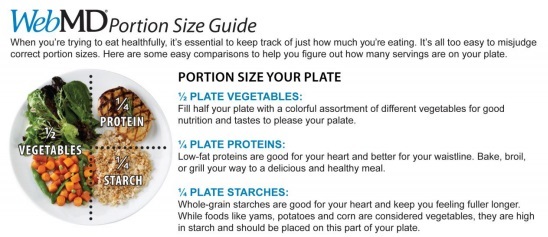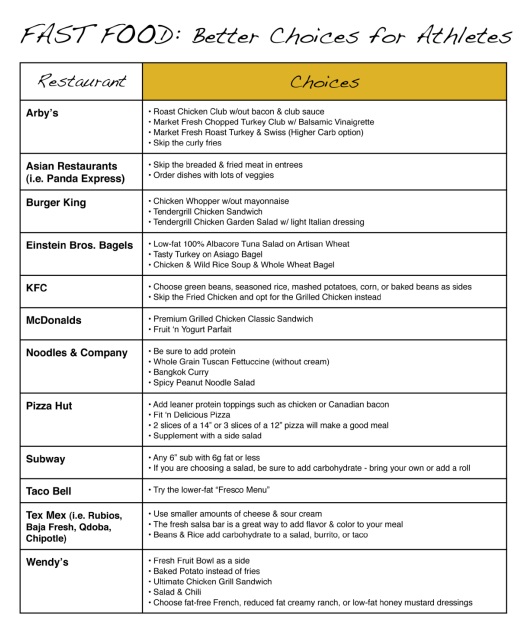For coaches and athletes nutrition is often a complicated struggle. To instruct athletes on how to properly fuel themselves can be difficult. Hopefully, at the conclusion of this exploration, the necessary knowledge and practical tips can be used by athletes in a very important time in their athletic careers allowing them to be successful.
Quick Facts...
· Athletes achieve peak performance by training and eating a variety of foods.
· Athletes gain most from the amount of carbohydrates stored in the body.
· Fat also provides body fuel; use of fat as fuel depends on the duration of the exercise.
· Exercise may increase the athlete's need for protein.
· Water is a critical for athletes. Dehydration can cause muscle cramping and fatigue.
Becoming an elite athlete requires good genes, good training and conditioning and a sensible diet. Optimal nutrition is essential for peak performance. Nutritional misinformation can do as much harm to the ambitious athlete as good nutrition can help.
Basic Nutrition
Carbohydrates
Carbohydrates are what provide the muscle with energy. Sugars and starches in the form of glycogen provide that energy. Not only do carbohydrates provide energy, but the fiber in these foods control fat and cholesterol along with aiding digestion. Carbohydrates are organic compounds that contain carbon, hydrogen, and oxygen in various combinations. They can be split into two categories: simple carbohydrates and complex carbohydrates. Simple carbohydrates can also be split into two categories: disaccharides and monosaccharide. These are known as sugars and are found in many foods. Sugars can be found in common foods such as fruits and milk. Complex carbohydrates, also known as starches include foods like potatoes cereals and pastas. Categories and groupings are often debated by nutritionist, especially when discussing complex carbohydrates. The bottom line is that carbohydrates are a basic form of energy and have and always will continue to fuel athletes during their activities. Throughout time we have seen carbohydrates labeled as either good or bad; we have seen trends such as low carbohydrate diets, low carbohydrate marketing infiltrate food culture. Most would agree that recent publicity have put carbohydrates in a negative light, but the truth remains that Nutrition Guide for College Aged Athletes carbohydrates in preparation to activities along with refueling post performances are crucial to being a healthy athlete.
Protein
Protein is very important in the maintenance and development of muscle tissue. Proteins are crucial in the production of key enzymes, antibodies, and hormones. Proteins also regulate the water levels of cells Protein is on the most important nutrients and has a wide variety of physiological functions that are imperative to physical performance. Muscle tissue is crucial to athletic ability and proteins are important in the development of that muscle tissue. There are 20 amino acids which can be combined to make up all the different types of protein needed for building and structure of the body. There are two types of amino acids; essential amino acids, that cannot be manufactured in the body and nonessential amino acids, those that can. Those foods that contain adequate amount of the nine essential amino acids used to support life and growth are known as complete proteins. The second, incomplete proteins have a deficiency in one or more amino acid and are unable to support life or growth. Animal protein is generally of a higher quality than that found in plants. For example 2 ounces of fish contains about 14 grams of protein whereas 2 ounces of beans contain about 5 grams of protein. Common sources of protein include animal foods in the milk and meat groups which generally have good sources of high quality protein. One glass of milk or 1ounce of meat poultry or fish contains about 7-8 grams of protein. One egg contains about 6 grams of high quality protein. Legumes, such as dry beans (black, garbanzo, kidney, lima) are also relatively good sources of protein. They are also high in carbohydrates, thus classified as a starch food.
Fats
Fat is the primary source of stored energy when the body is at rest and when the body is participating in long term aerobic activities. Fats from foods like butter and meat and other animals are usually saturated. Theses saturated fats contribute to cardiovascular disease and cancers. On the other hand fats from plants like olive oil, canola oil and corn oil are unsaturated and much healthier. One of the key functions of fat is to provide energy. Although fat may not be the first choice during high intensity aerobic or anaerobic, it is important to provide energy for low to moderate intensity exercises.
Other Key Nutrients
Minerals are elements that help to maintain structures in the body and regulate certain body processes. Examples of minerals at work are calcium and magnesium help keep bones strong while iron is important in oxygen transportation. Other minerals like sodium and potassium are crucial in blood volume. Vitamins act as nutrients that regulate metabolic reactions (life sustaining reactions) in the body. Some examples of crucial vitamins contributing to body processes Vitamins A and C are needed to assist the immune system. B vitamins aid the nervous system, and help with the cells burn energy. Water is very important in temperature regulation through sweating. Water is so important in that it constitutes 60 to 70 percent of body weight
Eating for Competition
When it comes to pre-event eating, it is important to understand that you are fueling and re- fueling your muscles. The goal is for your muscles to be fully loaded with glycogen and the body be hydrated. There is not one way to do this, but it is important that as an athlete you shy away from creating an upset stomach. Remember, everybody has a different tolerance of what they can and cannot eat prior to an athletic event. The following are some guidelines to keep you on track: when exercising more than an hour, be sure to choose enough carbohydrates throughout the day to fuel your body. Limit the high fat protein in-take; these are foods such as cheese, steak, hamburgers, and peanut butter. Be sure to eat foods that you are familiar with and comfortable digesting and use precaution when digesting foods with lots of sugars that can send you up, but will most definitely bring you right back down. It is important to allow your body time to digest, and depending on how close you are to your exercise will determine how much your body can handle. If you are one hour away from exercise your body can probably only handle a small snack, if you are one to two hours before exercise, maybe a blended meal or smoothie. Small meals are a good choice two to three hours before exercise and lastly for a large meal, allow for three to four hours digesting the food before exercise. A few things to remember about intense exercise is to allow yourself a little more time to digest. Moreover, if you are somebody that has a sensitive stomach or tends to get nervous prior to an athletic event or competition, take that into consideration. Do not pack your stomach full of food; try to rely on the night before for major intake and four to five hours before the event for a snack. Each athlete is different, so their food and the response to those foods will be different, so if it works for you don’t stop, if you are having trouble digesting before an event, review the guidelines above and make sure that you are following them properly.

